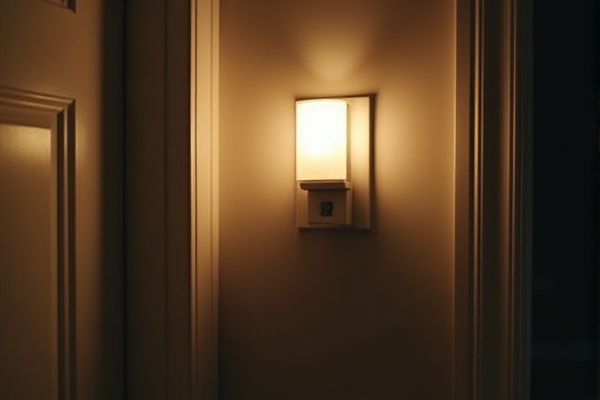
Motion sensor lights activate automatically when detecting movement, enhancing security and energy efficiency by illuminating only when needed. Timer lights operate on a preset schedule, providing consistent lighting regardless of activity, so exploring their differences can help you choose the best option for your needs. Read on to learn more about which lighting solution suits your preferences.
Table of Comparison
| Feature | Motion Sensor Light | Timer Light |
|---|---|---|
| Activation | Detects motion to turn on automatically | Turns on/off based on preset time |
| Energy Efficiency | High, lights only when movement is detected | Moderate, runs during set intervals regardless of activity |
| Security | Enhanced, deters intruders on detection | Basic, simulates presence on schedule |
| Convenience | Hands-free, automatic operation | Requires programming, predictable timing |
| Typical Use | Entrances, driveways, outdoor areas | Indoor lighting, holiday decoration, pathways |
| Cost | Generally higher initial cost | Lower cost and simpler technology |
Introduction to Motion Sensor Lights and Timer Lights
Motion sensor lights automatically detect movement and activate illumination, providing energy-efficient security and convenience. Timer lights operate based on preset schedules, turning on and off at specific times to create consistent lighting patterns. Both systems enhance home safety and energy management but differ in responsiveness and control methods.
How Motion Sensor Lights Work
Motion sensor lights detect infrared radiation emitted by moving objects to automatically turn on, providing illumination only when activity is present. This energy-efficient technology helps enhance security and convenience by eliminating the need for manual switching or preset time schedules found in timer lights. Your outdoor area benefits from responsive lighting that activates precisely when motion is detected, optimizing safety and energy savings.
How Timer Lights Operate
Timer lights operate by turning on and off at preset times determined by a built-in clock mechanism or digital settings, providing consistent illumination without manual intervention. These lights are ideal for scheduling lighting during specific hours, such as nighttime security or energy-saving routines. Your home benefits from automated control that reduces electricity consumption by ensuring lights are only on when needed.
Energy Efficiency: Motion Sensor vs. Timer Lights
Motion sensor lights save energy by activating only when motion is detected, reducing unnecessary power consumption compared to timer lights that operate based on preset intervals regardless of actual use. Timer lights may waste electricity if they stay on during periods with no activity, while motion sensors provide targeted illumination that adapts to your presence. Choosing motion sensor lighting enhances energy efficiency by minimizing light usage and lowering electricity costs over time.
Installation and Setup Differences
Motion sensor lights require installation of sensors that detect movement, often needing precise positioning to ensure accurate detection zones and avoid false triggers. Timer lights involve setting a predetermined on/off schedule, usually through a simple interface or dial, making setup straightforward without the need for sensor calibration. Motion sensor systems can be more complex to install due to wiring and sensitivity adjustments, whereas timer lights prioritize ease of programming and consistent operation.
Cost Comparison: Initial and Ongoing Expenses
Motion sensor lights typically have higher initial costs due to advanced sensor technology and installation complexity, while timer lights are generally more affordable upfront with simpler setups. Ongoing expenses for motion sensor lights can be lower as they operate only when movement is detected, reducing energy consumption compared to timer lights that may remain on unnecessarily. Maintenance costs for motion sensors may be higher due to sensor calibration or replacement needs, whereas timer lights usually require minimal upkeep.
Security Benefits of Motion Sensor Lights
Motion sensor lights enhance security by automatically illuminating when movement is detected, deterring potential intruders and alerting you to unexpected activity around your property. Unlike timer lights that operate on fixed schedules, motion sensor lights provide real-time responsiveness, ensuring your outdoor spaces are lit only when necessary. This adaptive lighting reduces energy consumption while maintaining heightened vigilance for your home's safety.
Convenience and Usability: Which Light is More User-Friendly?
Motion sensor lights offer superior convenience by automatically turning on when movement is detected, eliminating the need for manual operation and enhancing user-friendliness in everyday situations. Timer lights require programming and fixed schedules, which can be less flexible and may not respond to unexpected usage patterns as effectively. Your choice depends on whether you prioritize hands-free activation or preset control for managing lighting needs.
Maintenance and Lifespan Considerations
Motion sensor lights typically require less frequent maintenance due to their automatic on/off functionality, which reduces bulb usage and wear. Timer lights may need more regular adjustments and checks to ensure programming accuracy, potentially increasing maintenance efforts. In terms of lifespan, motion sensor lights often last longer as they operate only when motion is detected, minimizing energy consumption and extending bulb life.
Choosing Between Motion Sensor and Timer Lights: Which is Best for You?
Motion sensor lights activate automatically when movement is detected, providing security and energy savings by illuminating only when needed. Timer lights operate on a preset schedule, offering consistent lighting ideal for routine use or simulating occupancy. Your choice depends on whether you prioritize responsive lighting for security (motion sensor lights) or predictable, time-based control (timer lights).
 homyna.com
homyna.com